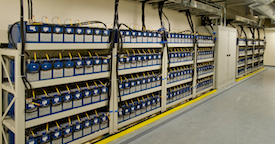Smart Battery Charging Solution for Industrial Applications
Industrial applications usually call for a battery charging solution that is more robust than an everyday standalone battery charger.
MEAN WELL’s HEP-1000 harsh environment power supplies are available with a battery charging mode and the curve can be programmed to suit the battery, or batteries being used.
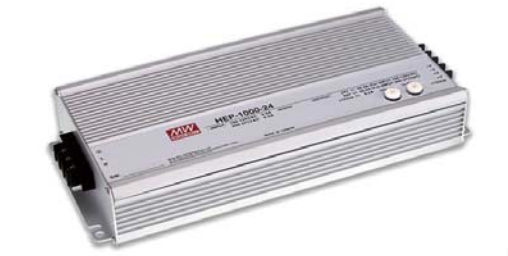
Electric vehicles and renewable energy are set to play a larger role in Australia's future, both of which are applications where this solution could be potentially used.
Lead Acid vs Lithium Batteries
The growing trend for many applications is to migrate from lead acid batteries to lithium.
Lead acid batteries have been used for many years as they have a high tolerance to fluctuations in the charging voltage, can operate in a wide range of ambient temperatures (think of the batteries in electronic school signs) and have a high surge current capacity. On top of that they are highly cost effective.
The downsides of lead acid batteries are their high self-discharging rate and relatively low charge/discharge cycles, which makes them less suitable for energy storage applications.
Lithium batteries offer high charging/discharging rates, a low self-discharge rate, and high energy density, making them a better option for storing energy for longer periods.
There are a range of different lithium battery chemistries with varying different performances.
Lithium cobalt oxide (LCO) has a high energy density and is popular in personal electronics. It is also the technology that is used in many electric vehicles (EVs). Lithium iron phosphate (LiFePO4) has a longer lifetime and relatively good thermal stability making it a better option for energy storage applications.
The major concern with lithium batteries is safety. Thermal runaway could cause the battery to catch on fire. In fact, one global car manufacture is recalling 82,000 EVs globally to replace the batteries as there is a low risk of a fire breaking out.
Therefore, lithium batteries require more deliberate charging/discharging.
Battery Charging Algorithms Explained
The nominal voltage of a single lead-acid cell is about 1.8-2.3V with a recommended maximum charging current of 0.3C.
Most commercial batteries have many cells in series and parallel to form a large capacity battery at more practical voltages like 12V, 24V, and 48V. Note the 12V, 24V, or 48V is often used loosely as an indication of the voltage range. The actual voltage varies based on the remaining capacity. For example, the open-circuit voltage of a typical 12V AGM lead-acid battery is between 10.8V (30% battery capacity) to 13.8V (100% capacity).
Because of the high self-discharge rate associated with lead-acid batteries, a 3-stage charging curve is often used. A typical charging cycle starts at the constant current stage (‘stage 1’ in the following graph), where the charger limits its output current to its maximum rating and slowly increases its output voltage. Once the battery voltage reaches the maximum charging voltage, the charger then switches to the constant voltage stage (‘stage 2’ of the following graph). The charger starts outputting its maximum rated voltage constantly and monitors its output current. Finally, the charger changes to the floating charging stage (‘stage 3’ in the following graph), where the charging current drops below about 10% of the rated current. At this stage, the charger would lower its output voltage to avoid overcharging. Although the battery at this point is close to being fully charged, it would still constantly draw power from the charger to compensate for its self-discharge.
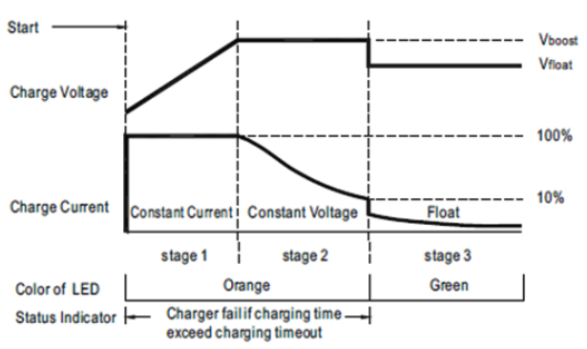
Lithium batteries have nominal voltages ranging from 3.2V to 4.4V with a maximum charging current up to 1C. The same chemistry type of lithium battery from different manufacturers can have different rated voltages and charging currents.
Unlike lead acid batteries, lithium batteries do not tolerate high charging voltages and do not require float charging to maintain their state of charge. Therefore, lithium batteries are often charged with a 2-stage charging method (as shown in the next graph) without the float charging stage.
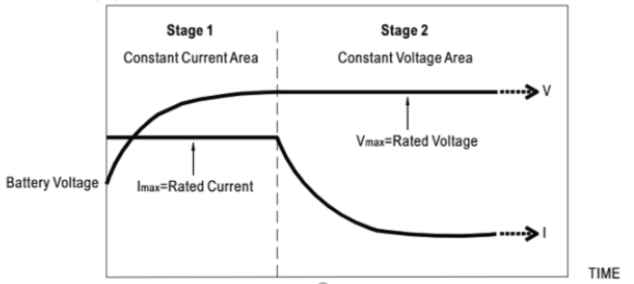
Cell imbalance is a concern for large lithium battery banks.
Due to manufacturing tolerances, the equivalent series resistance (ESR) of lithium cells cannot be matched perfectly. The differences among cells can cause cells in the same bank to be charged at a different voltage or current. The cells with a lower ESR will always be fully charged or discharged first, so those cells will age and fail faster.
The imbalance of cells not only shortens the lifetime of the battery, but it could also potentially cause thermal runaway and become a safety hazard. To solve this issue, large lithium battery banks should always be equipped with a battery management system (BMS). The basic function of a BMS is to monitor the state of charge and balance cells either passively or actively.
Passive BMS balances cells by discharging the cells with a higher charge using power resistors. It is robust and relatively easy to design, but not efficient and less effective than active balancing.
On the other hand, active BMS charges cells individually to match the states of charge. Because active BMS has charging control for each cell, some lithium battery banks with an active balancing BMS only require constant voltage AC/DC power supplies as the charger.
This is where MEAN WELL’s charging solution comes in.
MEAN WELL’s Smart Battery Charging Solution
As we have already mentioned, batteries of different chemistry types and from different manufacturers could have different characteristics.
It is recommended (for lead acid batteries) and mandatory (for lithium batteries) to have the charging curve optimised for brand and model of the batteries being used to ensure reliability, longevity, and safety.
MEAN WELL’s programmable chargers that can be used in conjunction with the SBP-001 smart charger programmer offer flexibility and a user-friendly interface for adjusting the charging curve.
Using the HEP-1000 series as an example, the default setting of the HEP-1000-48 is as a 48V constant voltage power supply, with a maximum power rating of 1008W. The HEP-1000-48 can be connected to the SBP-001 programmer to enable the charger mode.
The default charging curve is a 3-stage (as per the following image) for typical sealed lead-acid batteries, with a 57.6V boost charging voltage and 55.2V float charging voltage. The charging voltage and current can be easily adjusted within a range of 36~60V and 3.5~17.5A respectively for other types of lead-acid batteries.
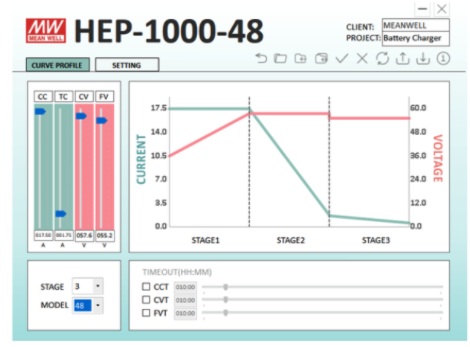
By simply selecting the 2-stage charging mode, HEP-1000-48 also can be used for charging lithium batteries with the same adjustment range.
For example, to charge a 20Ah LiFePO4 battery with a maximum charge voltage of 56V, the ‘CV’ and ‘CC’ options (shown below) can be set to 56V and 17.5A for the fastest possible charging time. The user could lower the charging current to prevent temperature rise caused by high currents and lower the voltage to avoid the possibility of overcharging.
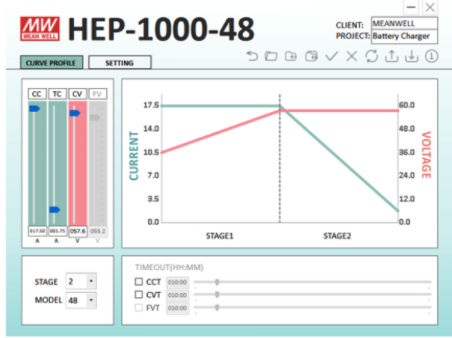
Battery Chargers and Electrical Safety Approvals in Australia
Stand-alone battery chargers are classed as prescribed electrical equipment in Australia, also known as Level 3 in scope products.
Australian electrical certification is mandatory for this type of battery charger.
However, in many OEM applications the battery charger is used as a component within a piece of finished equipment or a locked control cabinet. The HEP-1000 series battery chargers are especially designed for this type of use and are therefore considered to be a non-prescribed item, not requiring the electrical safety certificate.
Conclusion
MEAN WELL’s programmable chargers can be used to customise charging curves required by either lead-acid or lithium batteries. Adjusting the charging voltage and current based on the temperature and age of the battery can preserve the battery and optimise its capacity.
For further information please contact ADM.
IS THIS INFORMATION USEFUL?
If so, why not share it with your peers and colleagues. Simply click on the blue LinkedIn share icon below.


